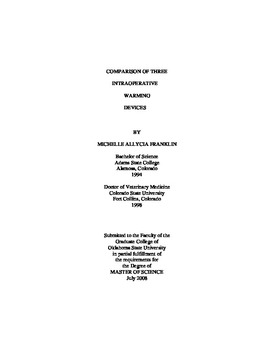| dc.contributor.advisor | Bartels, Kenneth E. | |
| dc.contributor.author | Franklin, Michelle Allycia | |
| dc.date.accessioned | 2014-04-16T03:15:53Z | |
| dc.date.available | 2014-04-16T03:15:53Z | |
| dc.date.issued | 2008-07-01 | |
| dc.identifier.uri | https://hdl.handle.net/11244/9813 | |
| dc.description.abstract | Thermal homeostasis is important for the overall well-being of people and animals. Hypothermia is common during and after surgeries. The combination of anesthesia, exposure to a relatively cold operating room environment, evaporation from surgical incisions, and conductive cooling produced by administration of relatively cool intravenous fluids can result in unintended perioperative hypothermia. Anesthesia-induced hypothermia may alter physiological mechanisms of thermoregulation and may lead to prolonged duration of drug action, myocardial ischemia, coagulopathies, decreased resistance to surgical wound infections, and prolonged recovery time. Unless active warming measures are taken, the patient will lose body heat and endure hypothermic consequences. Therefore, proactive warming measures are needed to prevent excessive heat loss from the patient to the environment. The goal of any warming device is to prevent intraoperative hypothermia or treat preexisting hypothermia. The efficacy of three active warming devices (T/pump circulating water, Bair Hugger, and Thermal-V) that may be used alone or in combination to minimize intraoperative hypothermia when applied to patients undergoing prolonged surgeries were evaluated. Our hypothesis was that the Thermal-V warming unit would be comparable or better than the other units. There were no statistically significant differences between patient temperatures for each warming device in surgeries that lasted 180 minutes. The combined circulating water blanket and forced air warming system and forced air warming device used alone were significantly better in preventing excessive heat loss in patients undergoing celiotomies. The Thermal-V unit was able to prevent excessive heat loss in patients undergoing surgeries up to 150 minutes. Mean patient weight, body condition score, ASA status, and duration of surgical procedures did not have any significant effect on the outcome. Ambient operating room temperature, pre-operative temperature, temperature at time of induction, and temperature at time of sterile preparation did not have any significant effect on the results either. Given some of the drawbacks with other warming systems, the Thermal-V offers an alternative method of active warming with advantages in terms of cost and application to a wide variety of surgical procedures. | |
| dc.format | application/pdf | |
| dc.language | en_US | |
| dc.publisher | Oklahoma State University | |
| dc.rights | Copyright is held by the author who has granted the Oklahoma State University Library the non-exclusive right to share this material in its institutional repository. Contact Digital Library Services at lib-dls@okstate.edu or 405-744-9161 for the permission policy on the use, reproduction or distribution of this material. | |
| dc.title | Comparison of Three Intraoperative Warming Devices | |
| dc.type | text | |
| dc.contributor.committeeMember | Rochat, Mark | |
| dc.contributor.committeeMember | Confer, Anthony W. | |
| osu.filename | Franklin_okstate_0664M_2855.pdf | |
| osu.college | Center for Veterinary Health Sciences | |
| osu.accesstype | Open Access | |
| dc.description.department | Veterinary Pathobiology | |
| dc.type.genre | Thesis | |
